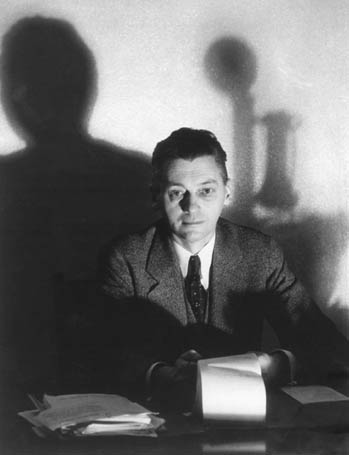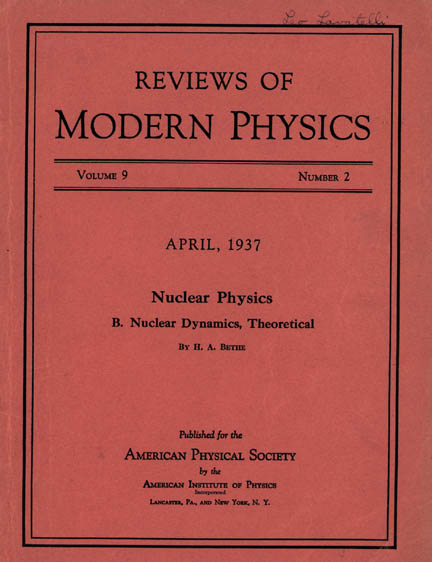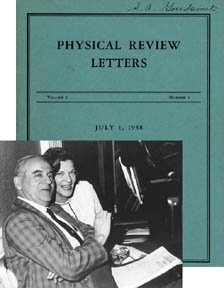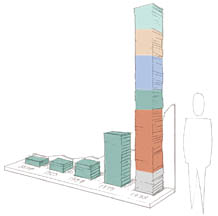100 Years of the American Physical Society
To Advance and Diffuse the Knowledge of Physics will be on exhibit in its entirety at the National Institutes of Standards and Technology (NIST) headquarters in Gaithersburg, MD through the end of 1999. Visitors are welcome.
Expansion of Journals
Growth in numbers of physicists meant more research to be published. The Physical Review grew rapidly in size, quality, and prestige. Reviews of Modern Physics was introduced to offer authoritative summaries of specialized areas of research. The need to give others early word of fundamental work led to the establishment of Physical Review Letters.
Reviews of Modern Physics
 John Torrence Tate |
In 1928 John Torrence Tate, managing editor of the Physical Review, felt the need for a new type of physics journal-one that would contain definitive, up-to-date reports on branches of physics. He solicited comments from 54 prominent physicists and asked each to consider writing for the new journal. Response was positive, and the first issue of Reviews of Modern Physics appeared in 1929.
Bethe Bible
 Bethe Bible |
Rev. Mod. Phys. (1936-1937) This series of authoritative papers by Hans Bethe and colleagues long served as a textbook for the new field of nuclear physics. The authors incorporated Bohr's theory of the compound nucleus and Breit and Wigner's theory of the shape of nuclear resonance, which appeared during the writing of the articles.
Most Heavily Cited RMP Paper 1943 - Stochasticity: S. Chandrasekhar [click here for larger photo]
Physical Review Letters
 Physical Review Letters |
To speed up reports of major discoveries, Phys. Rev. introduced a "Letters to the Editor" section in 1929. By 1957, the time lag for "Letters to the Editor" was nearly as long as for regular articles. To speed up publication, Samuel Goudsmit, the journal's editor, created Physical Review Letters.
PRL Highlights
1967 - Electroweak Interactions: S. Weinberg
1982 - Spooky Q.M. Actions at a Distance: A. Aspect, et al.
1982 - Scanning Tunneling Microscopy: G. Binnig, et al.
1987 - High-Tc Superconductors: C. W. Chu, et al.
1998 - Neutrino Oscillations: Y. Fukuda, et al.
PR 'Baby' Grows From an Inch to Over Thirteen Feet
 PR 'Baby' |
Physical Review, affectionately called 'the creeping green' published all physics topics until it began splitting by subject in 1970. Today, a year of PR and PRL comprises almost 100,000 pages and has multi-colored covers.
PR Highlights:
1916 - Measurement of h: R. Millikan
1923 - Compton Scattering: A. H. Compton
1927 - Diffraction of Electrons: C. Davisson & L. H. Germer
1932 - Cyclotron: E. O. Lawrence & M. S. Livingston
1935 - EPR Paradox: A. Einstein, B. Podolsky & N. Rosen
1948 - Transistor: J. Bardeen & W.H. Brattain
1949 - Feynman Diagrams: R. P. Feynman
1957 - BCS Superconductivity: J. Bardeen, L. Cooper & J. R. Schrieffer
1958 - Laser: A. L. Schawlow & C. H. Townes
|
|
|
| Curator: | Sara Schechner Genuth Gnomon Research |
| Exhibit Director: | Barrett Ripin |
| APS History: | Harry Lustig |
| Journals History: | R. Mark Wilson |
| Researchers: | George Trigg Ruth Kastner Steven Norton Amy Halsted |
| Exhibit Design: | Puches Design Inc. |
| Fabrication: | Malone Displays |
©1995 - 2024, AMERICAN PHYSICAL SOCIETY
APS encourages the redistribution of the materials included in this newspaper provided that attribution to the source is noted and the materials are not truncated or changed.
Editor: Barrett H. Ripin
Associate Editor: Jennifer Ouellette
November 1999 (Volume 8, Number 10)
Articles in this Issue

